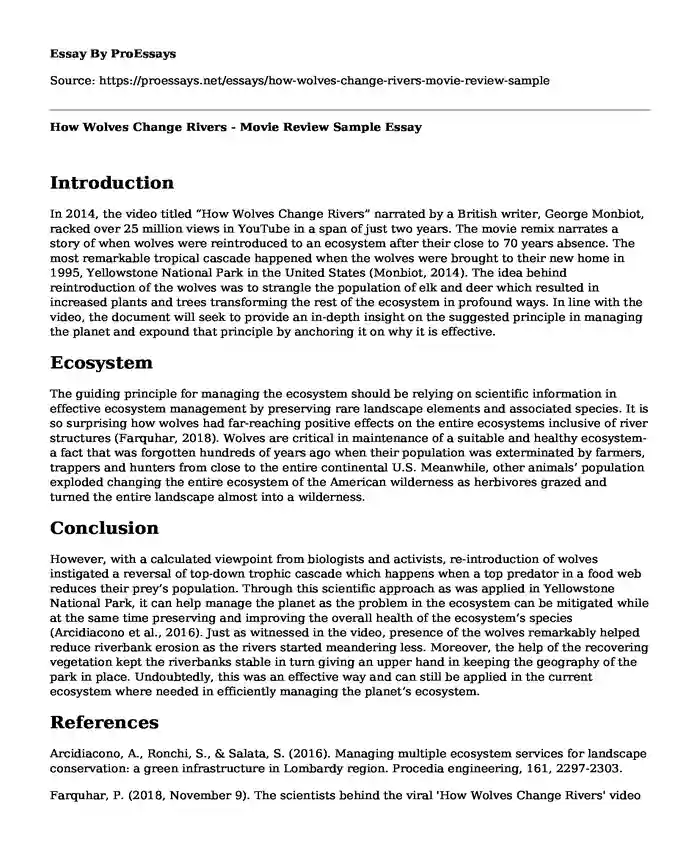Introduction
In 2014, the video titled “How Wolves Change Rivers” narrated by a British writer, George Monbiot, racked over 25 million views in YouTube in a span of just two years. The movie remix narrates a story of when wolves were reintroduced to an ecosystem after their close to 70 years absence. The most remarkable tropical cascade happened when the wolves were brought to their new home in 1995, Yellowstone National Park in the United States (Monbiot, 2014). The idea behind reintroduction of the wolves was to strangle the population of elk and deer which resulted in increased plants and trees transforming the rest of the ecosystem in profound ways. In line with the video, the document will seek to provide an in-depth insight on the suggested principle in managing the planet and expound that principle by anchoring it on why it is effective.
Ecosystem
The guiding principle for managing the ecosystem should be relying on scientific information in effective ecosystem management by preserving rare landscape elements and associated species. It is so surprising how wolves had far-reaching positive effects on the entire ecosystems inclusive of river structures (Farquhar, 2018). Wolves are critical in maintenance of a suitable and healthy ecosystem- a fact that was forgotten hundreds of years ago when their population was exterminated by farmers, trappers and hunters from close to the entire continental U.S. Meanwhile, other animals’ population exploded changing the entire ecosystem of the American wilderness as herbivores grazed and turned the entire landscape almost into a wilderness.
Conclusion
However, with a calculated viewpoint from biologists and activists, re-introduction of wolves instigated a reversal of top-down trophic cascade which happens when a top predator in a food web reduces their prey’s population. Through this scientific approach as was applied in Yellowstone National Park, it can help manage the planet as the problem in the ecosystem can be mitigated while at the same time preserving and improving the overall health of the ecosystem’s species (Arcidiacono et al., 2016). Just as witnessed in the video, presence of the wolves remarkably helped reduce riverbank erosion as the rivers started meandering less. Moreover, the help of the recovering vegetation kept the riverbanks stable in turn giving an upper hand in keeping the geography of the park in place. Undoubtedly, this was an effective way and can still be applied in the current ecosystem where needed in efficiently managing the planet’s ecosystem.
References
Arcidiacono, A., Ronchi, S., & Salata, S. (2016). Managing multiple ecosystem services for landscape conservation: a green infrastructure in Lombardy region. Procedia engineering, 161, 2297-2303.
Farquhar, P. (2018, November 9). The scientists behind the viral 'How Wolves Change Rivers' video are back and have made a small update to their claim. Business Insider Australia. Monbiot, G. (2014). How wolves change rivers [Video file]. Retreived from
https://www. youtube. com/watch.
Cite this page
How Wolves Change Rivers - Movie Review Sample. (2023, Dec 12). Retrieved from https://proessays.net/essays/how-wolves-change-rivers-movie-review-sample
If you are the original author of this essay and no longer wish to have it published on the ProEssays website, please click below to request its removal:
- Hero's Journey Analysis Based on the Movie "Mulan" - Paper Example
- Censorship vs Selection in Libraries Essay
- Essay Sample on Documentaries: Sparking Conversations and Enlightening Minds
- Paper Example on Investigating PDGFA-Driven Gliomagenesis: Impact on Malignant Glioblastomas
- Essay Example on Speaker's Music Business: A Life-Changing Journey
- The Avengers Endgame - Movie Analysis Essay
- Essay Example on Understanding Hollywood Movies: A Reflection of American Culture







